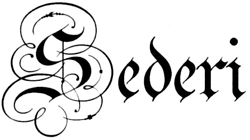Download this Style sheet in portable document format
Before sending your manuscript, please make sure that your piece complies with all these requirements:
- Check the word count (including footnotes and references)
- Articles: 6000–8000 words.
- Notes: 3000–5000 words.
- Reviews: 1000–2000 words.
- Include an abstract (100-150 words) and 5-10 keywords.
- Format, citations, and references follow SEDERI Yearbook’s style sheet.
- Use British English spelling and punctuation.
- Remove personal details from the file of the contribution.
- Attach a file with your name, affiliation, title of contribution, postal and email address and telephone number.
- Originality: the research piece has not been previously published, in whole or in part.
- Copyright: no copyright of another journal, author or publisher is infringed.
- Obtain permissions for publication of copyrighted material (pictures, photographs, etc.).
Note that non-standard ASCII characters or unusual fonts, particularly special characters in Old and Middle English, Phonetics or Greek, illustrations, graphics, tables, pictures, etc. must be consulted with the editors.
Margins: 2,5 cm for all the margins.
Font: Times New Roman 12 throughout the text (including title, subtitles, notes, quotations, etc.)
Headings and subheadings should be capitalized in the same font and size.
Line spacing: 1’5.
Use Footnotes instead of endnotes.
Please avoid headers, footers, page numbers.
Spelling and punctuation: British English
Quotations:
- Short quotations (up to 40 words) should be incorporated into the text, using quotation marks (“ ”).
- Longer quotations should be indented without quotation marks and no italics.
Sederi Yearbook follows the 16th edition of the Chicago Manual of Style (CMS). You can find a quick citation guide at http://www.chicagomanualofstyle.org/tools_citationguide.html
1. References within the text and in footnotes
SEDERI Yearbook uses the author-date citation system, that is, the identification of sources is given in parenthetical citation in the text as they are mentioned or needed for support in the text.
· The information in parenthesis should include: author + publication year + page number(s).
Example: (Owen 1996, 27)
· If the author’s name is mentioned in the text, there is no need to repeat it in the citation.
Example: … Owen (1996, 27), has downplayed the importance of personal satire…
Footnotes are intended for providing further detail / commentary or for explanatory purposes.
2. List of bibliographical references
A list of works cited should be provided at the end of the paper under the heading “References.”
Here you can find some examples of bibliographical citation for the reference list:
· Books
Gillespie, Alexandra. 2006. Print Culture and the Medieval Author: Chaucer, Lydgate, and Their Books 1473-1557. Oxford: Oxford University Press.
Colón Semenza, Greg, ed. 2010. The English Renaissance in Popular Culture. An Age for All Time. New York: Palgrave Macmillan.
· Edited/translated books
Sidney, Philip. 1992. Astrophil y Stella. Edited by Fernando Galván Reula. Madrid: Cátedra.
· Journal articles
Kottman, Paul A. 2013. «Shakespeare’s Hermeneutic Legacy: Response to Kristin Gjesdal.» Shakespeare Quarterly 64 (1): 70-70.
Quinn, William A. 2011. «Red Lining and Blue Penciling The Kingis Quair.» Studies in Philology 108: 189-214. DOI: 10.1353/sip.2011.0011
· Book chapters
Snyder, Susan. 2001. «The Genres of Shakespeare’s Plays.» In The Cambridge Companion to Shakespeare, edited by Margreta de Grazia, and Stanley Wells, 83-97. Cambridge: Cambridge University Press.download this Style sheet in portable document format
